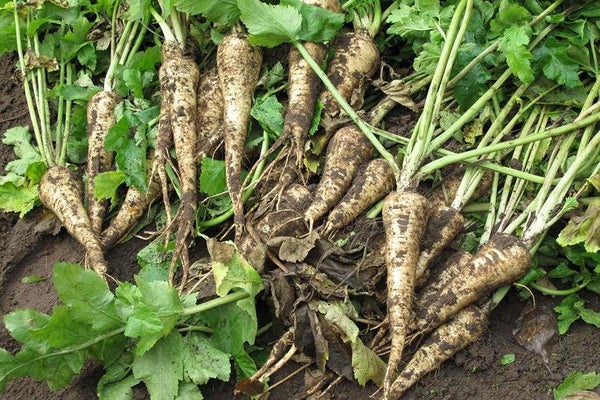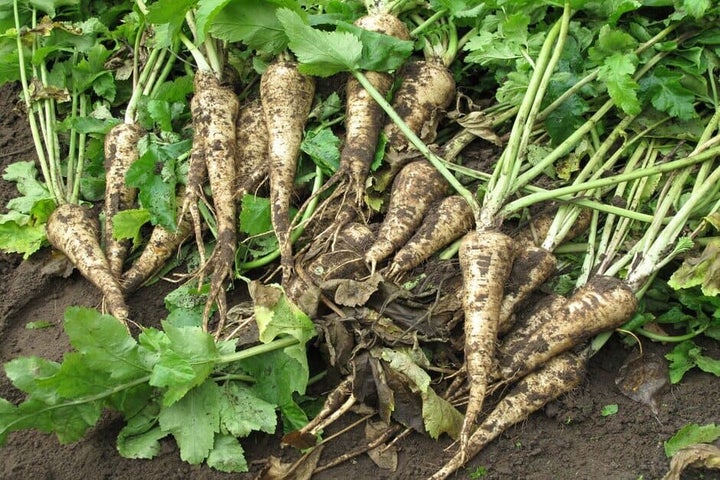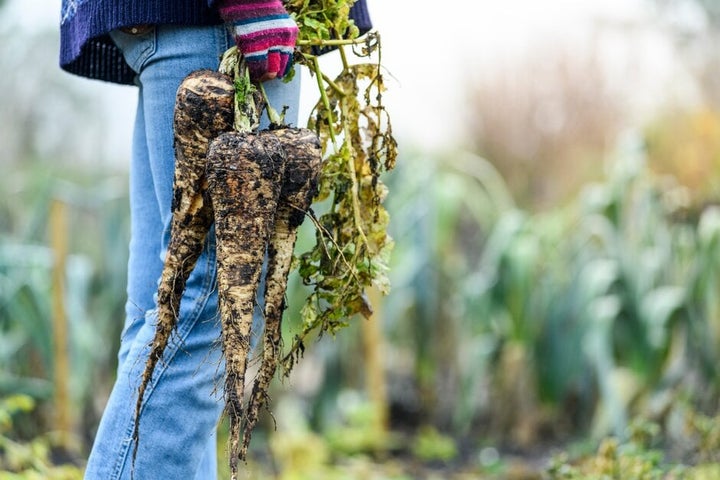
Getting Started
Delicious roasted or added to hearty winter stews, parsnips need little maintenance and can be left in the ground until you’re ready to eat them. Sow in spring and you’ll have sweet, tasty parsnips by autumn – and for your Christmas dinner too.

A traditional and popular autumn and winter crop, parsnips (Pastinaca sativa) are slow growing, but these deliciously sweet, earthy roots are well worth the wait. After sowing them outdoors in spring, ideally in light, free-draining soil, they'll need weeding when young and watering during any long dry spells.
Jobs to do now
Harvest
Month by Month
Sow
Harvest
Choosing What To Grow

There are several varieties to choose from, varying mainly in size and shape. Most form long, tapering roots, although a few are shorter and more bulbous, which is preferable if you have heavy, shallow or stony soil. Roots range in colour from cream to pure white, although all have a similar flavour. It’s worth choosing a variety that is canker-resistant and has an RHS Award of Garden Merit (AGM), which means it should grow well and crop reliably – see our list of AGM fruit and veg (135kB pdf) and our Recommended Varieties below. You can also see many crops, such as parsnips, in the veg plots at most RHS gardens, so do visit to see how they’re grown, compare different varieties and pick up inspiration and tips.
What and where to buy
Parsnip seeds are widely available in garden centres and from online suppliers. Only buy enough for the current year though, as old seeds germinate poorly, so to avoid disappointment it’s best to buy fresh ones every spring.
Recommended Varieties

‘Albion’ AGM
Evenly tapered root about 30cm (1ft) long with smooth white skin, slow to discolour. Resistant to canker.

‘Gladiator’ AGM
Produces good harvests of well-flavoured, long, slender roots with smooth skins. Resistant to canker.

‘Pearl’ AGM
Very uniform, long, slender roots with a smooth white skin. Keeps well over winter in the ground.
Preparing The Ground
Choose an open, sunny area with deep, light soil that drains readily. Avoid sowing in ground recently used for parsnips or carrots, as carrot fly may be present. And if you’re growing carrots too, keep the two crops away from each other.
Prepare the soil by removing as many stones as possible and loosen heavy clay or compacted soil, so your parsnips grow long, straight roots that don’t fork. Don’t dig in any organic matter immediately before sowing, as this can also cause roots to branch and fork. Soil that has been improved with well-rotted manure or garden compost the previous year is ideal. If you’re practising no-dig, the surface and sow into the mulch.
Sowing
Parsnips have a reputation for being tricky to germinate, but if you wait until the soil has warmed up in mid-spring, use fresh seeds and sow plenty, you should have good results. Sowing indoors is not recommended, as parsnips form a tap root that doesn’t transplant well. Although you may find recommendations to start sowing in February, it’s usually too cold for reliable , except in very mild locations – wait until temperatures are around 12°C (54°F). Sowings made in March and April, and even early May, tend to do much better. Covering the soil with cloches for a couple of weeks before sowing also helps to dry it out and warm it.
Make a shallow , 1cm (½in) deep, and water along the base if the soil is dry. Scatter the seeds thinly along the drill, or sow three at 15cm (6in) intervals – germination can be unreliable, so it’s best to sow more than you need. Cover the seeds with soil and water again if no rain is forecast. Space additional rows 30cm (1ft) apart. For more sowing tips, see our guides below.
Parsnip seeds are slow to germinate, so be patient – can take from 14 to 30 days to appear, depending on conditions. Weed regularly and water during dry spells, both before and after germination. Putting cloches or biodegradable fleece over the seedlings for a few weeks will help to get them off to a good start. Thin out the seedlings to leave one every 15cm (6in), removing the smaller, weaker ones.
Top Tip
Sow a fast-growing crop such as radishes between your parsnips to maximise your growing opportunities. The radishes will be harvested long before the slow-growing parsnips need the space.
Plant Care
Watering
Water young parsnips during dry spells until well established. More mature plants are fairly drought tolerant, but to avoid the roots splitting, keep the soil evenly moist. For tips on making good use of water, see our guides below.
Mulching
Spread a thick layer of , such as home-made garden compost, around parsnips when the soil is warm and damp, to hold in moisture and suppress weeds.
Weeding
Keep the soil weed-free, especially when parsnips are young, so they don’t have to compete for water, or light. Hand-weeding, rather than , avoids accidentally damaging the top of the root and making it susceptible to canker (see Problems, below). Also try not to touch the leaves when weeding, as the smell may attract carrot fly. Once the crop is growing strongly, the dense foliage usually hinders weed growth.
Protecting the crop
Parsnips are vulnerable to carrot fly damage, so it’s best to put protection in place from the start – the most effective method is to cover the crop with insect-proof mesh.
Harvesting

Parsnips are ready to lift when the leaves start to die down in late summer or autumn. It’s a good idea to wait until after the first heavy frost though, as this intensifies their sweetness and flavour. Make sure your crop is clearly marked with canes or labels before the leaves disappear, so the roots are easy to find in winter.
Use a garden fork to carefully ease the long roots out of the ground intact. Parsnip roots are very hardy, so can be left in the ground into winter and harvested as required. However, they can be difficult to harvest from frozen ground, so it may be worth lifting a few extra in November to ensure you have parsnips to enjoy however cold it gets. Alternatively, cover the ground with straw as insulation.
Problem Solving
Seed can be poor and slow, especially in cold soil, so don’t sow too early. Always use fresh seeds and protect early sowings with cloches to keep them warm and aid germination. Other potential problems include forked or distorted roots, usually due to stony or compacted soil, or if manure or garden have been added recently. Parsnip roots can split if growth is erratic, so water in dry spells to avoid this. They can also be damaged by carrot fly, so cover the crop with insect-proof mesh. Parsnip canker (an orange/ ) can affect the roots too, especially if already damaged. Resistant varieties (such as ‘Albion’ and ‘Picador’) are available.
Common Problems

Root vegetables: splitting
When root vegetables are harvested, they are sometimes found to have split open, rendering many crops useless and causing much disappointment. There a...

Carrot fly
The larvae of carrot fly can make a large proportion of carrots and allied vegetable crops inedible.




